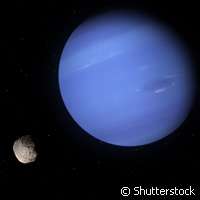A total of 10 new planets have been unearthed by an international team of scientists, and one of these is orbiting a star just a few tens of millions years old.
Using the CoRoT (Convection, Rotation and Transits) space telescope, operated by the French Space Agency (CNES), astrophysicists from the UK and France were able to see planets from outside our solar system, so-called 'exoplanets', when they were in transit, i.e. when they passed in front of their stars.
As well as the planet orbiting the unusually young star, the team also uncovered seven hot Jupiter-like planets, two Neptune-sized planets orbiting the same star, and a planet slightly smaller than Saturn.
Dr. Suzanne Aigrain from the Department of Physics at Oxford University in the United Kingdom said: 'Finding planets around young stars is particularly interesting because planets evolve very fast initially, before settling into a much steadier pattern of evolution. If we want to understand the conditions in which planets form, we need to catch them within the first few hundred million years. After that, the memory of the initial conditions is essentially lost. In the case of CoRoT-18 [the planet orbiting the young star], different ways of determining the age give different results, but it's possible that the star might be only a few tens of millions of years old. If this is confirmed, then we could learn a lot about the formation and early evolution of hot gas giant planets by comparing the size of CoRoT-18b to the predictions of theoretical models.'
When the CoRoT telescope detects a transit, additional observations are then made from the ground using several different telescopes around the world. Despite not being able to see the planets directly, astronomers can use the space- and ground-based data to precisely measure the new planets' sizes, masses, and orbits.
Another planet that surprised the scientists was CoRoT-24, which is located around 4,400 light years from Earth: this star, just a little smaller than our Sun, is orbited by two transiting planets. 'The first of these planets is three times larger than the Earth, and takes 5.1 days to orbit the star, whilst the second is 4.8 times larger than the Earth and takes 11.8 days to complete an orbit. So these planets are similar to Neptune in size, but much hotter,' comments Dr. Aigrain. "However, we don't know yet whether they are also similar to Neptune in composition, because even with the best instruments in the world, we could only obtain upper limits on their masses. It's the first system with two transiting planets found by CoRoT."
The planet found with a similar size to Saturn is located around 2,000 light years from us. This planet takes about 10 days to orbit its star that is slightly hotter than our Sun. The team deduced that its density is not much more than that of Jupiter, which means it has a predominantly gaseous composition. However it is possible that this planet could also be made-up of significant quantities of rock and ice.
Additionally, among the new discoveries was CoRoT-17b, a massive giant 10-billion-year-old planet that orbits a star twice as old as our Sun. It takes 3.7 days to complete its orbit. Another discovery was CoRoT-19b, a planet with the same mass as Jupiter but 1.5 times the size. Its density is much less than that of Saturn, the least dense planet in our solar system.
CoRoT-20b was one of the most significant discoveries: it has an elongated 9.2-day orbit that could be linked to its extremely high density - twice that of Mars.
Provided by CORDIS
























